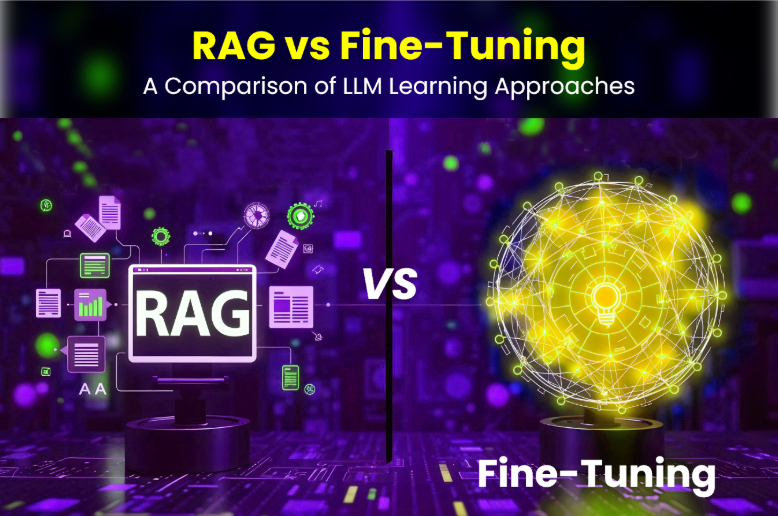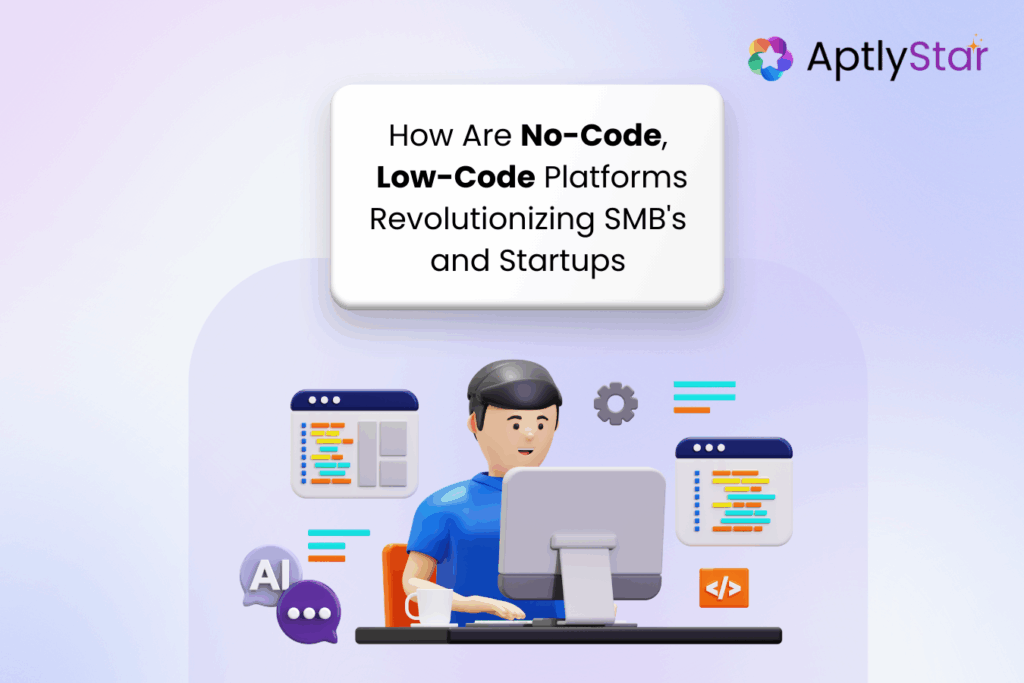As organizations rapidly adopt large language models (LLMs) for applications like ChatGPT, two popular methods for integrating proprietary and domain-specific data have emerged: Retrieval-Augmented Generation (RAG) and Fine-Tuning. According To Microsoft, RAG enhances prompts with external data, while Fine-Tuning embeds new knowledge directly into the model. Despite their growing use, the advantages and limitations of each approach remain unclear.
In this blog, let’s get into a deep analysis into a comparison of these two LLM techniques.

What Is Retrieval-Augmented Generation (RAG) in large language models?
Retrieval-Augmented Generation (RAG) is a framework introduced by Meta in 2020 that connects large language models (LLMs) to a curated, dynamic database, allowing them to access up-to-date information for more accurate, context-aware responses. Rather than relying only on pre-trained data, RAG integrates external data for real-time queries.
Key points:
- Complex architecture: RAG involves components like prompt engineering, vector databases (e.g., Pinecone), embedding vectors, and data pipelines, all working together to process queries and retrieve the most relevant data, improving response accuracy.
- Query and retrieval process: Upon receiving a user query, RAG searches its connected database to retrieve the most relevant, up-to-date information, using advanced algorithms to ensure precise and contextually appropriate results.
- Integration with LLM: The retrieved data is combined with the user’s query and passed into the LLM. This enables the model to generate responses that are more accurate and specifically tailored to the query, thanks to real-time data access.
- Benefits and complexity: Building a RAG system requires complex data pipelines and coordination with a data team. However, it enhances response reliability, making it ideal for industries needing AI solutions in customer service, technical support, and business intelligence, where up-to-date, accurate responses are critical.
What is Fine-tuning?
Fine-tuning involves training a large language model (LLM) on a smaller, domain-specific dataset, allowing it to adjust its parameters for specialized tasks. This method is effective in making models understand niche terminologies and nuances, making it suitable for industries like legal, customer support, or technical writing. Unlike RAG, which retrieves external data, fine-tuning integrates this knowledge into the model itself. However, it demands significant computational resources and can be time-consuming, though it can outperform general-purpose models in specific tasks.
Key points:
- Domain-specific training: Fine-tuning aligns the model with industry-specific requirements, enhancing its performance for specialized tasks.
- Challenges: It requires substantial computational resources, data labeling, and time to effectively train and adjust the model.
- Outcomes: When done well, fine-tuned models can be highly specialized and deliver precise, superior results in niche applications.
Examples of When to Use RAG & When to Use Fine-Tuning?
When to Use Retrieval-Augmented Generation (RAG) | When to Use Fine-Tuning |
– Chatbots: RAG framework be used for accessing relevant information from guides and manuals to provide personalized responses. | – Content Recommendation: We can leverage the Fine-tuning method for analyzing customer preferences in entertainment and news. |
– Educational Software: Used for providing context-specific answers based on topic-specific study materials. | – Named-Entity Recognition (NER): Used for recognizing specialized terms in legal or medical contexts. |
– Legal Tasks: Used for streamlining document reviews by utilizing the latest legal precedents. | – Sentiment Analysis: Used for interpreting tone and emotion in text more accurately. |
– Medical Research: Used for integrating current data to enhance diagnosis and treatment accuracy. | – Generic LLMs: Often fall short in nuanced emotional interpretation. |
– Translation: Used for improving context understanding in translations by leveraging internal data. |
|
Retrieval-Augmented Generation (RAG) Use Cases
Boosting Customer Support with RAG-Enabled Chatbots
- RAG enhances support chatbots by providing accurate and contextually relevant responses.
- Chatbots access current product details and customer-specific information for effective assistance.
- Improved customer experiences lead to higher satisfaction rates.
- Practical applications include handling inquiries, resolving issues, performing tasks, and gathering feedback.
- This comprehensive functionality streamlines customer service and responds better to individual needs.
Speeding Up the Onboarding of New Employees
- RAG improves employee onboarding by streamlining training processes.
- Integrates retrieval components to access company-specific documents and training materials.
- Provides real-time, relevant information tailored to new hires.
- Dynamic responses incorporate the latest documents and past queries, enhancing learning.
- Results in a more engaging onboarding experience and faster assimilation into company culture.
Case Study: Aptlystar.ai Streamlined HR operations & offered seamless onboarding experience
Challenge: In a large organization, managing employee resources—covering everything from onboarding and HR inquiries to training schedules and internal communications—proved cumbersome. Manual processes were leading to inefficiencies and reducing employee satisfaction.
Solution: A company reached out to Aptly technology for combatting this challenge and after consulting with the tech team they used AptlyStar.ai, a comprehensive AI platform where you can create, manage, deploy bots using preferred data, based on latest llms. This platform efficiently automated a variety of HR tasks: from onboarding new hires and handling HR-related inquiries to managing training schedules, leave requests, and real-time company policy updates. Integrated with the company’s HR systems, AptlyStar.ai provided personalized assistance to employees right from their first day.
Impact: AptlyStar.ai (this word will be linked to product page) streamlined internal HR operations, reduced workload for HR teams, enhanced the onboarding experience for new hires, and boosted overall employee satisfaction by delivering timely, accurate support.
Fine-Tuning Real- Life Use Cases
- Recent studies show that fine-tuned models can outperform standard models like GPT-3 for specific tasks.
- Fine-tuning small models can be more cost-effective than using larger, general-purpose models.
- Snorkel AI developed a data-centric foundation model that connects foundation models with enterprise AI.
- Their Snorkel Flow tool includes fine-tuning and prompt building, empowering data science teams for critical use cases.
- The Snorkel model matches the quality of a fine-tuned GPT-3 while being 1,400 times smaller, needing less than 1% of the ground truth labels, and costing only 0.1% as much to operate.
RAG vs. Fine-Tuning: How to Choose?
Retrieval-augmented generation (RAG) and fine-tuning are two distinct methods for enhancing the output of your language model. To determine which approach to use, consider the following questions:
- Complexity: How much complexity can your team manage? RAG is less complex to implement, requiring only coding and architectural skills, whereas fine-tuning necessitates a broader skill set, including natural language processing (NLP), deep learning, model configuration, data preprocessing, and evaluation.
- Accuracy: What level of accuracy do your responses require? RAG is effective for generating current responses and reducing hallucinations, though accuracy can vary in domain-specific contexts. Fine-tuning, on the other hand, is tailored to improve an LLM’s understanding in specific domains, yielding more precise responses.
- Data Type: Is your data dynamic or static? RAG excels in dynamic environments, accessing real-time data from internal sources without needing to retrain the LLM. Fine-tuning can improve the accuracy of responses but relies on static training datasets, which may become outdated.
- Budget: Are costs a concern? RAG primarily incurs costs related to setting up data retrieval systems. Fine-tuning, however, is generally more expensive due to the need for more labeled data and higher computational resources.
- Hallucinations: How critical is it to minimize hallucinations? RAG is less likely to produce hallucinations and biases since it bases LLM responses on information retrieved from reliable sources. Fine-tuning can reduce hallucination risks by using domain-specific data but may still yield incorrect responses with unfamiliar queries.
Conclusion
Choosing between Retrieval-Augmented Generation (RAG) and fine-tuning depends on your specific needs, such as AI model response accuracy, data dynamics, and budget. Both of these LLM architectures have unique strengths. RAG leverages real-time data retrieval and dynamic knowledge retrieval to offer context-aware AI responses, while fine-tuning allows for domain-specific model customization. External data integration for AI ensures broader knowledge access, minimizing hallucinations.
At Aptly Technology, we provide tailored AI services that leverage the strengths of both RAG and fine-tuning. Our solutions are designed to enhance your business operations, whether through advanced chatbots for customer support or customized AI models for specialized tasks. By integrating cutting-edge technologies, we empower organizations to harness the full potential of AI, ensuring efficient, accurate, and responsive systems that drive innovation and success.
Incorporate the power of Retrieval-Augmented Generation with aptlystar.ai! Our platform allows you to create RAG-based bots that deliver precise, context-aware responses tailored to your specific needs.
Try aptlystar.ai today and experience the future of AI-driven solutions that enhance your business efficiency and customer interactions!





